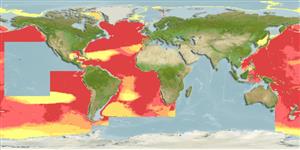Common names from other countries
>
Lophiiformes (Anglerfishes) >
Oneirodidae (Dreamers)
Etymology: Oneirodes: Greek, 'oneiros' = a dream or dreamlike or out of a dream (suggesting this fish is so strange and marvelous that can exist only in dreams) (Ref. 86949); eschrichtii: Named after D.F. Eschricht, Danish naturalist (Ref. 6885).
More on author: Lütken.
Environment: milieu / climate zone / depth range / distribution range
Ökologie
seewasser bathypelagisch; tiefenbereich 750 - 2500 m (Ref. 86949). Deep-water
Circumglobal: In tropical to temperate waters. Eastern Atlantic: off Madeira, Portugal, Ireland and Iceland.
Size / Gewicht / Alter
Maturity: Lm ? range ? - ? cm
Max length : 28.8 cm SL Männchen/unbestimmt; (Ref. 5951); 29.7 cm TL (female)
Rückenflossenweichstrahlen (insgesamt): 5-7; Afterflossenweichstrahlen: 4. Esca with anterior appendage bearing papillae and a few short filaments at distal tip; posterior appendage never branched. Characterized by having similar esca to that of O.bulbosus and O.anisacanthus; lacks numerous tapering distal filaments of the anterior appendage of O.bulbosus and lateral escal appendage of O.anisacanthus; subopercle without indentation on posterodorsal margin; length of ventral fork of opercle 20.7-31.9% SL; ratio of lengths of dorsal and ventral forks of opercle 0.44-0.69; absence of epibranchial teeth; presence of teeth on pharyngobrachial II; upper jaw teeth 24-50; lower jaw teeth 29-56;teeth on vomer 4-8; dorsal fin rays 5-7; anal fin rays 4; pectoral fin rays 15-19; head length 33.3-46.2% SL; head depth 34.7-55.4% SL; premaxilla length 22.4-38.9% SL; lower-jaw length 34.3-55.7% SL; illicium length 17.8-38.6& SL (Ref. 86949).
Mesopelagic species.
Life cycle and mating behavior
Geschlechtsreife | Fortpflanzung | Ablaichen | Eier | Fecundity | Larven
Bertelsen, E., 1990. Oneirodidae. p. 498-507. In J.C. Quero, J.C. Hureau, C. Karrer, A. Post, and L. Saldanha (eds.) Check-list of the fishes of the eastern tropical Atlantic (CLOFETA). JNICT, Lisbon; SEI, Paris; and UNESCO, Paris. Vol. 1. (Ref. 10524)
IUCN Rote Liste Status (Ref. 130435)
CITES (Ref. 128078)
Not Evaluated
Bedrohung für Menschen
Harmless
Nutzung durch Menschen
Mehr Information
NamenSynonymeMetabolismusRäuberÖkotoxikologieFortpflanzungGeschlechtsreifeAblaichenFecundityEierEientwicklung
ReferenzenAquakulturAquakultur ProfilZuchtlinienGenetikElectrophoresesVererbbarkeitKrankheitenVerarbeitungMass conversion
PartnerBilderStamps, Coins Misc.LauteCiguateraGeschwindigkeitSchwimmstilKiemenoberflächeOtolithsGehirngrößeSehfähigkeit
Tools
Zusatzinformationen
Download XML
Internet Quellen
Estimates based on models
Preferred temperature (Ref.
115969): 2.3 - 5.8, mean 3.6 (based on 1799 cells).
Phylogenetic diversity index (Ref.
82804): PD
50 = 0.5000 [Uniqueness, from 0.5 = low to 2.0 = high].
Bayesian length-weight: a=0.01995 (0.00906 - 0.04395), b=3.01 (2.83 - 3.19), in cm Total Length, based on all LWR estimates for this body shape (Ref.
93245).
Trophic level (Ref.
69278): 4.4 ±0.7 se; based on size and trophs of closest relatives
Widerstandsfähigkeit (Ref.
120179): mittel, Verdopplung der Population dauert 1,4 - 4,4 Jahre. (Preliminary K or Fecundity.).
Fishing Vulnerability (Ref.
59153): Low vulnerability (20 of 100).
